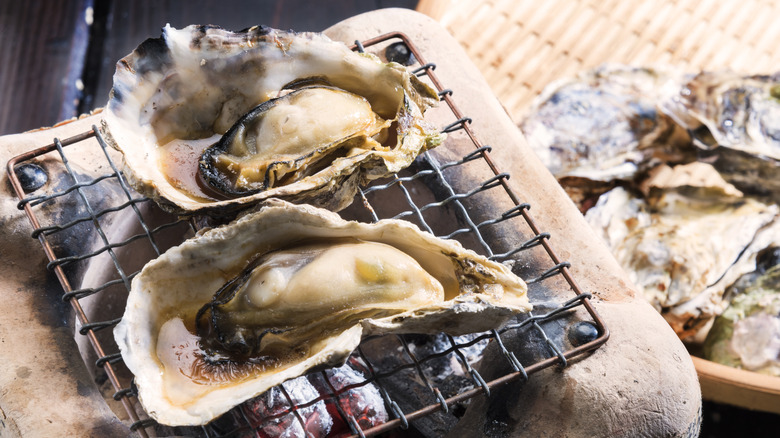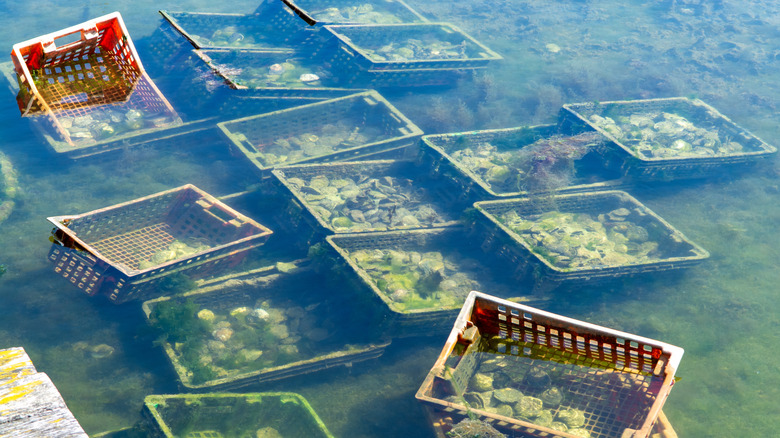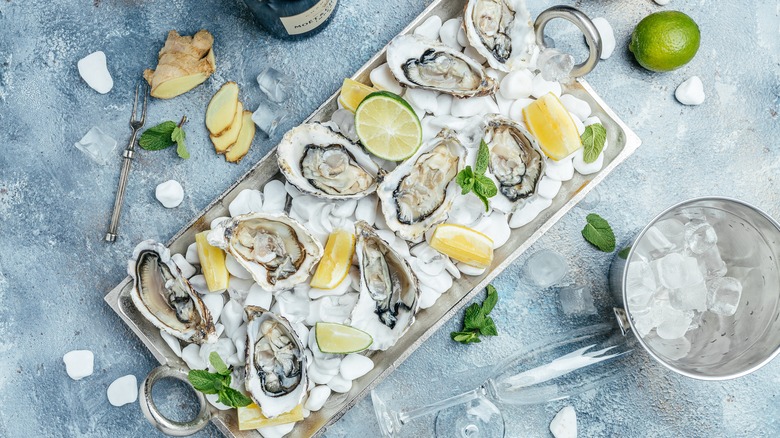Before They Were A High Class Staple, Oysters Were The Food Of The Poor
Everybody knows that oysters can be luxurious, but that's not all they can be. So, what exactly are they, then? First things first, oysters are different from clams and other similar sea creatures. They belong to a specific family of coastal mollusks with two distinct halves connected by a hinge (think of how you can open up an oyster to find the pearl inside), according to Encyclopedia Britannica.
Oysters are valuable for more than just their pearls. People have been eating oyster meat for thousands of years now, and there are several ways to enjoy oysters, whether cooked or raw. That's because, despite their drab and slimy appearance, oysters provide plenty of calcium, iron, and protein, which is all delivered via their delicate, rich, and salty flavors (via National Geographic). Better yet, there are many different species of oysters, found all over the world. So then, why is there such an air of exclusivity surrounding them, and has that reputation always existed for oysters?
Oysters were once a dime a dozen
It turns out, oysters used to be readily available and very affordable. Take Britain, for example, which according to the Victorian Web, has been consuming oysters since ancient Rome reached the island, if not longer. Once the Middle Ages rolled around, this practice became all the rage in Britain, since the church at the time forbade eating meat for a whole third of the year. As a result, people turned to seafood, including oysters, for food. It was a matter of practicality, and back then, there were plenty of oysters off the nearby coasts. Plus, not only were those oysters overabundant and cheap, but they also packed plenty of nutrients into one affordable morsel — perfect for efficient meal planning.
This oyster obsession extended across the pond, as well. Per Atlas Obscura, New York City was once considered the oyster capital of the world. New York harbor used to be filled with oysters, and in the 1800s, New Yorkers were collectively eating a million oysters each day. Indeed, during the 19th century, the sheer quantity of oysters in the area meant you could find them for dirt cheap at street carts alongside snacks like peanuts and refreshments such as beer.
So, what changed?
Unsustainable practices lowered oyster supplies
It was too much of a good thing. As noted by National Geographic, restrictions often need to be put in place to prevent overharvesting of oysters. Additionally, these filter feeders are particularly susceptible to polluted water, so big cities like New York tend to kill off oyster populations or at least make them too toxic for consumption. Thus, almost 100 years ago, New York City's oyster beds officially closed down. Nowadays, per Ag MRC, the U.S. oyster industry mainly relies on the Chesapeake Bay, Gulf of Mexico, and Pacific Coast for its domestic oysters. However, Chesapeake Bay — which is near New York Harbor — has seen its own oyster industry shrink dramatically over the past century or so.
Britain is a similar story. The Victorian Web explains the British obsession with oysters eventually led to oyster beds being overharvested. So, prices rose, and soon enough, only the rich were shelling out for the top quality stuff. It didn't help that, per The Telegraph, industrialization polluted Britain's coasts. Then, in 1963, a particularly cold winter nearly wiped out what was left of the British oyster population. Thanks to the introduction of a foreign species, the British oyster industry has been improving in recent decades. Still, on both sides of the pond, low supply and relatively stable demand means that this historical food-of-the poor is now seen as an upper class delicacy.


